Key takeaways:
- Photography techniques like depth of field and composition significantly affect the storytelling aspect of images.
- Double exposure creates compelling visual narratives by layering images, inviting viewers to interpret emotional connections.
- Essential tools for double exposure editing include Adobe Photoshop and mobile apps, which allow for creativity and fine-tuning of images.
- Choosing harmonious subjects and experimenting with blending modes are key strategies for successful double exposure edits.
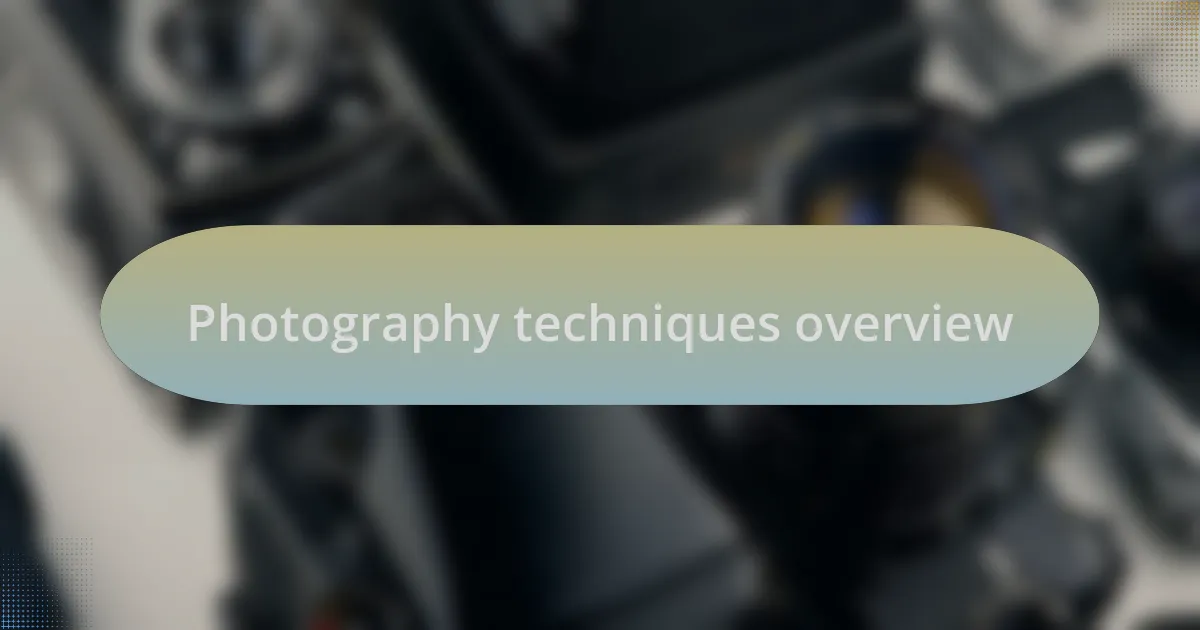
Photography techniques overview
Photography is an art that encompasses a variety of techniques, each with its own unique charm and purpose. For instance, working with depth of field can completely alter the narrative of a photograph. I remember experimenting with this technique during a vibrant summer afternoon, focusing on a single flower while allowing the background to blur into a dreamy bokeh; it felt like I had captured a moment of magic.
Then there’s the concept of composition, which is undeniably the backbone of a compelling photograph. I’ve often asked myself, “How can the arrangement of elements tell a story?” My answer always resonates with the rule of thirds. When I framed a sunset using this approach, it allowed the horizon to breathe while guiding the viewer’s eye across the shot, truly enhancing the emotional weight of the image.
Light is another essential component that can never be overlooked. The way light falls on a subject can evoke emotions and create an atmosphere. I vividly recall a late afternoon shoot where the golden hour bathed everything in warmth. That soft, glowing light transformed the scene and made it feel almost ethereal; I couldn’t help but wonder how such simple changes in light can profoundly impact our perception of a moment captured in time.
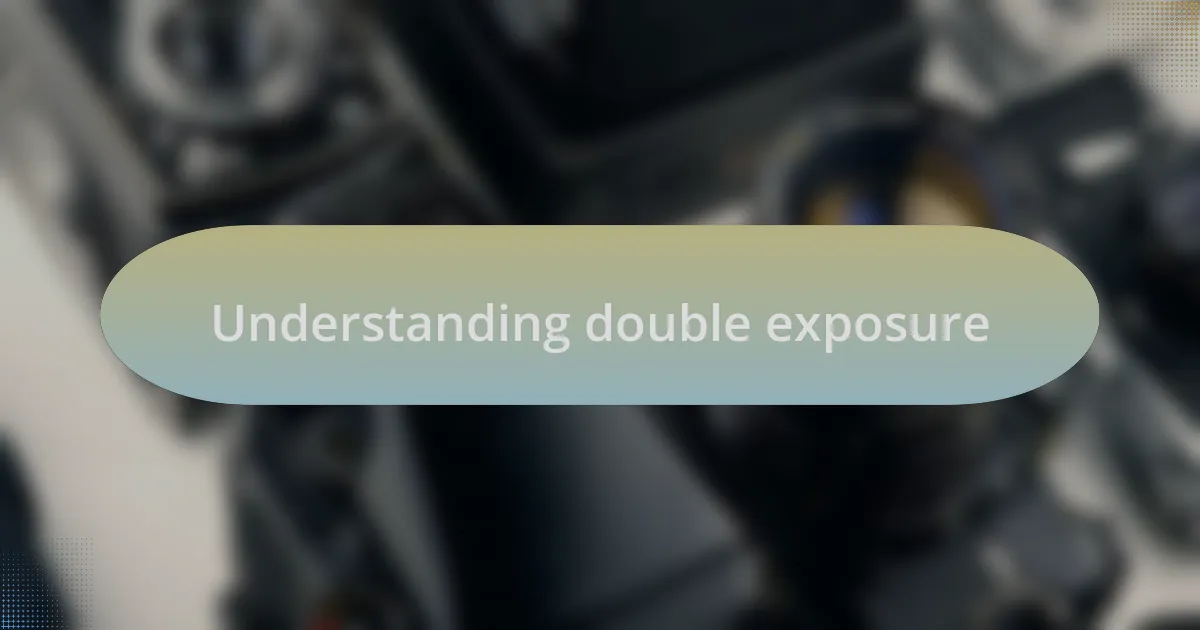
Understanding double exposure
Double exposure is a fascinating technique that layers two images to create one striking composition. When I first tried my hand at this method, I felt a rush of excitement as I watched the two images merge on my screen, revealing unexpected connections. Have you ever wondered how a city skyline could blend seamlessly with a portrait? That moment of visual discovery is what makes double exposure so captivating.
At its core, double exposure invites us to explore relationships between subjects and the emotions they convey. One time, I combined a portrait of a friend, filled with joy, with the serene landscape of a forest—a juxtaposition that told a story of inner peace amidst chaos. This layering can provoke thought and elevate emotions in a way that individual images simply can’t achieve. It challenges the viewer to interpret and feel, prompting questions about the narrative behind the image.
Understanding the technical aspects is crucial for successful double exposure edits. I remember experimenting with different blending modes in editing software, trying to find the perfect harmony between the two images. Each adjustment felt like stepping into a new frame of mind, where imagination could run wild. So, what will your double exposure journey reveal about the world around you?
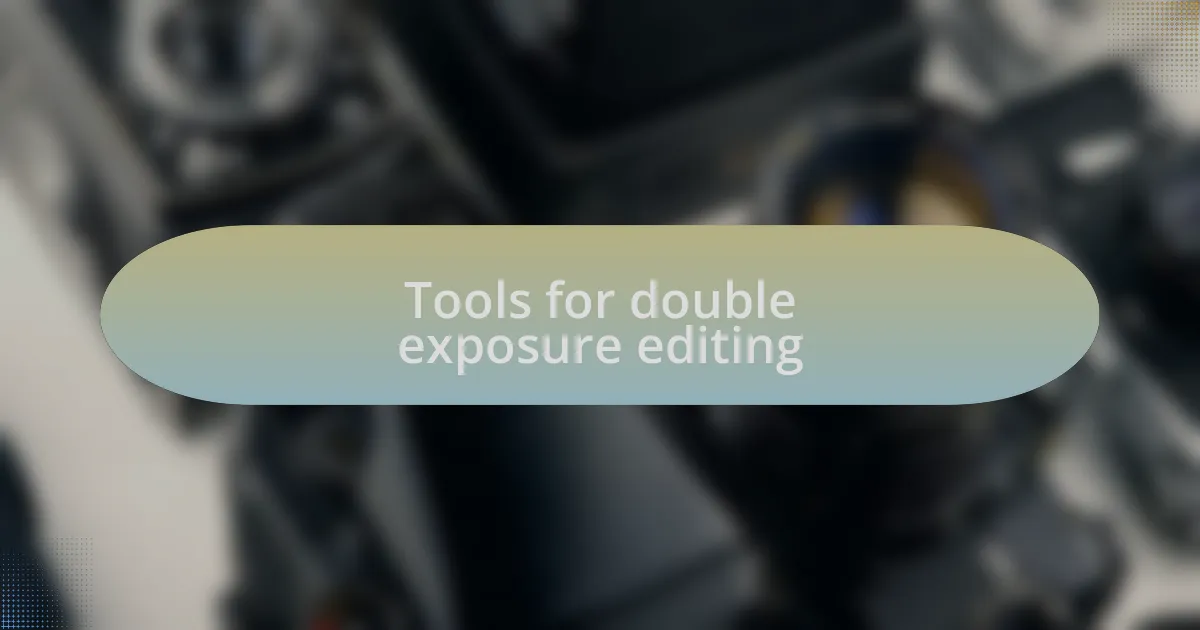
Tools for double exposure editing
When it comes to double exposure editing, the right tools can make all the difference. I often rely on Adobe Photoshop for its advanced layering and masking capabilities. The ability to adjust opacity and use blending modes like “Screen” or “Overlay” allows me to experiment freely, creating harmonies that I could only dream of before.
In addition to Photoshop, I’ve found mobile apps like Snapseed and PicsArt incredibly useful for on-the-go edits. One time, while traveling, I was able to quickly double-expose a sunset silhouette against a cityscape right from my phone, and that spontaneity added an unexpected thrill to my creative process. Have you ever felt the urge to capture a moment and let inspiration guide your edits?
Lightroom is another essential tool that I frequently turn to, particularly for fine-tuning colors and exposure before layering images. Playing with sliders to enhance contrast and saturation lets me inject emotion into my double exposures, transforming a simple edit into a heartfelt visual story. How do you bring your own emotions into your photography work?
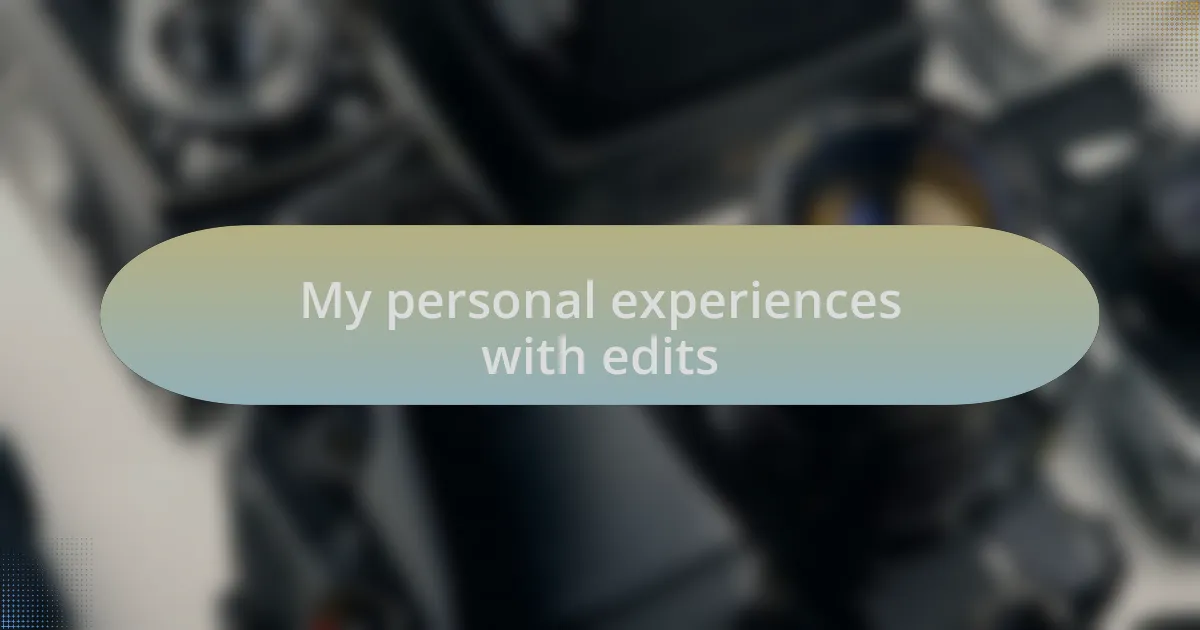
My personal experiences with edits
My journey with edits has been a fascinating exploration of creativity and emotion. I remember the first time I layered two images, a portrait and a landscape, and watched them blend seamlessly. The resulting piece ignited a thrill in me; it was as if I had discovered a new language in photography, one that conveyed feelings words could not.
There was a specific project I worked on that truly challenged my editing skills. I had taken a picture of a forest and, on a whim, overlaid it with an image of a dancer in motion. The collision of stillness and movement captured my fascination with how edits could evoke a story or a feeling beyond the surface. Have you ever felt a pull to experiment in a way that completely reshapes your understanding of your art?
Through these editing experiences, I’ve learned that each adjustment can shift the narrative of an image. Simple tweaks, like changing opacity or adding a color wash, can evoke entirely different emotions. Reflecting on these edits brings me joy, knowing that I’m continuously learning to express my vision in more profound ways. What emotional responses do you seek in your images?
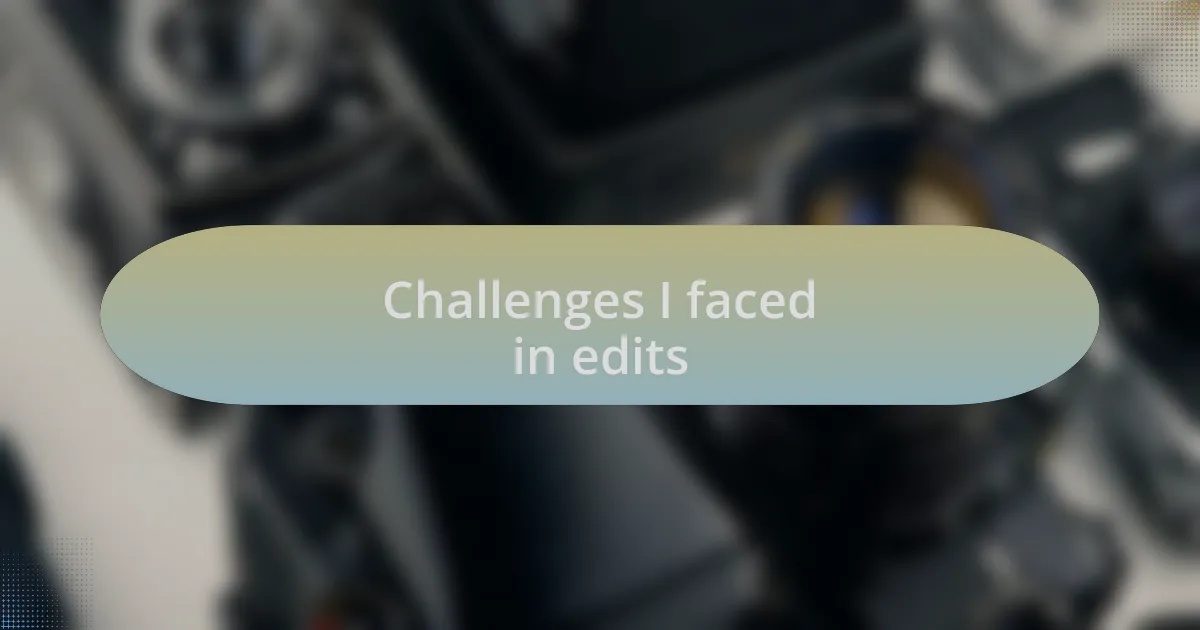
Challenges I faced in edits
One of the biggest challenges I faced in double exposure edits was ensuring that my images actually communicated the intended emotion. I vividly recall spending hours trying to merge a sunset silhouette with a stormy sea, only to find that they clashed more than they complemented each other. It left me questioning: how do you truly harmonize two distinct subjects without losing their individual essence?
Another difficulty arose with the technical aspects of blending images. I remember experiencing frustration when I couldn’t achieve the right balance of lighting and contrast. In one instance, I tried to overlay a city skyline with a close-up of a flower, but the color temperatures were so misaligned that the final result looked garish instead of ethereal. How do you navigate the fine line between artistic vision and technical execution?
Additionally, there were moments of self-doubt as I stared at the screen, scrutinizing my edits. I battled the feeling that I was only scratching the surface of what was possible with double exposures. It made me ponder whether my artistic intuition was enough to guide me through the complexities of this editing style. Have you ever questioned your skills in such a way, wondering if the next edit could finally be the breakthrough you’ve been longing for?
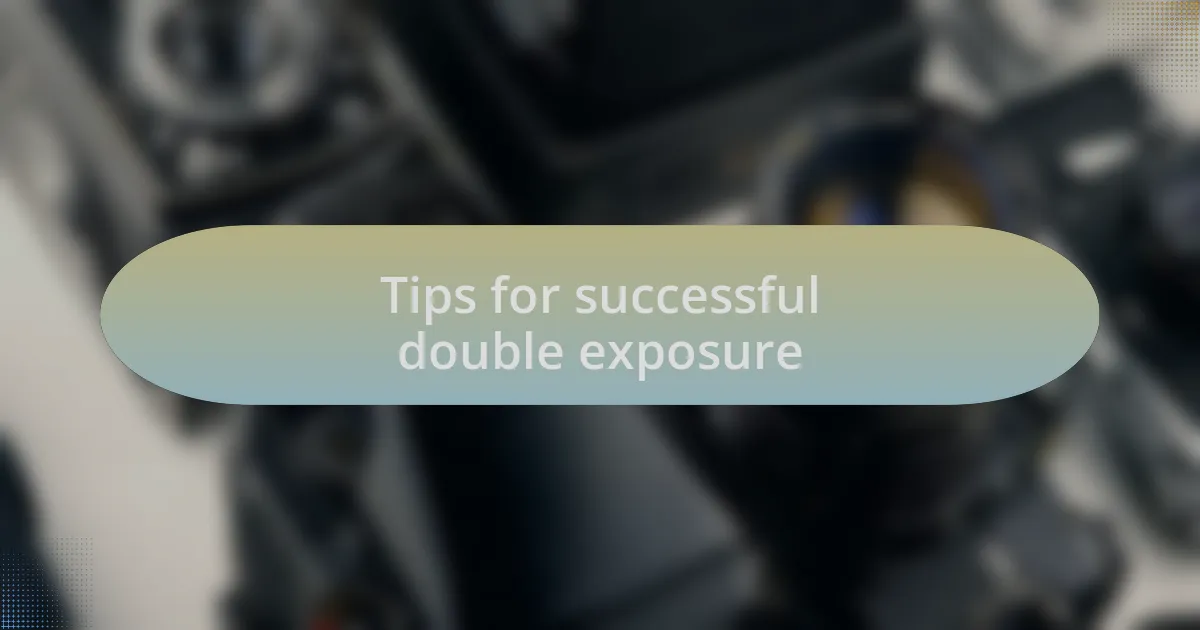
Tips for successful double exposure
When it comes to double exposure, one essential tip I’ve learned is to carefully choose your subjects. I once combined an image of a dancer with a bustling cityscape, and the result felt chaotic rather than beautiful. It taught me the importance of harmony—select subjects that complement each other’s form and narrative. How do you find the right balance in your own work?
Another crucial element is experimentation with blending modes and opacity. In one of my earlier projects, I experimented with different layers and discovered that lowering the opacity created a softer, more ethereal effect—almost like how dreams feel. This approach allowed me not just to create visually appealing images, but also to evoke deeper emotions. Have you tried playing with these settings to manipulate mood and atmosphere in your edits?
Lastly, don’t underestimate the power of post-processing. I had a breakthrough after applying subtle color grading to an image, enhancing the emotional tone of my double exposure. I realized that fine-tuning colors can elevate the concept behind the image. What methods do you find effective for enhancing mood in your photographs?